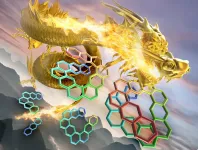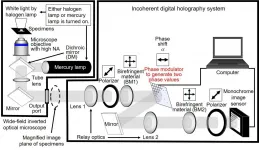Scientists identify locations of early prion protein deposition in retina
Findings indicate cones precede rods as targets for infection
2021-01-29
(Press-News.org) WHAT:
The earliest eye damage from prion disease takes place in the cone photoreceptor cells, specifically in the cilia and the ribbon synapses, according to a new study of prion protein accumulation in the eye by National Institutes of Health scientists. Prion diseases originate when normally harmless prion protein molecules become abnormal and gather in clusters and filaments in the human body and brain.
Understanding how prion diseases develop, particularly in the eye because of its diagnostic accessibility to clinicians, can help scientists identify ways to slow the spread of prion diseases. The scientists say their findings, published in the journal Acta Neuropathologica Communications, may help inform research on human retinitis pigmentosa, an inherited disease with similar photoreceptor degeneration leading to blindness.
Prion diseases are slow, degenerative and usually fatal diseases of the central nervous system that occur in people and some other mammals. Prion diseases primarily involve the brain, but also can affect the eyes and other organs. Within the eye, the main cells infected by prions are the light-detecting photoreceptors known as cones and rods, both located in the retina.
In their study, the scientists, from NIH's National Institute of Allergy and Infectious Diseases at Rocky Mountain Laboratories in Hamilton, Montana, used laboratory mice infected with scrapie, a prion disease common to sheep and goats. Scrapie is closely related to human prion diseases, such as variant, familial and sporadic Creutzfeldt-Jakob disease (CJD). The most common form, sporadic CJD, affects an estimated one in one million people annually worldwide. Other prion diseases include chronic wasting disease in deer, elk and moose, and bovine spongiform encephalopathy in cattle.
Using confocal microscopy that can identify prion protein and various retinal proteins at the same time, the scientists found the earliest deposits of aggregated prion protein in cone photoreceptors next to the cilia, tube-like structures required for transporting molecules between cellular compartments. Their work suggests that by interfering with transport through cilia, these aggregates may provide an important early mechanism by which prion infection selectively destroys photoreceptors. At a later study timepoint, they observed similar findings in rods.
Prion protein also was deposited in cones and rods adjacent to ribbon synapses just before the destruction of these structures and death of photoreceptors. Ribbon synapses are specialized neuron connections found in ocular and auditory neural pathways, and their health is critical to the function of retinal photoreceptors in the eye, as well as hair cells in the ear.
The researchers say such detailed identification of disease-associated prion protein, and the correlation with retinal damage, has not been seen previously and is likely to occur in all prion-susceptible species, including people.
Next the researchers are hoping to study whether similar findings occur in retinas of people with other degenerative diseases characterized by misfolded host proteins, such as Alzheimer's and Parkinson's diseases.
INFORMATION:
ARTICLE:
J Striebel et al. Prion-induced photoreceptor degeneration begins with misfolded prion protein accumulation in cones at two distinct sites: cilia and ribbon synapses. Acta Neuropathologica Communications DOI: 10.1186/s40478-021-01120-x (2021).
RELATED:
J Striebel et al. Microglia are not required for prion-induced retinal photoreceptor degeneration. Acta Neuropathologica Communications DOI: 10.1186/s40478-019-0702-x (2019).
J Carroll et al. Microglia are critical in host defense against prion disease. Journal of Virology DOI: 10.1128/JVI.00549-18 (2018).
WHO:
Bruce Chesebro, M.D., chief of NIAID's Laboratory of Persistent Viral Diseases, is available to comment on this study.
CONTACT:
To schedule interviews, please contact Ken Pekoc, (301) 402-1663, kpekoc@niaid.nih.gov.
NIAID conducts and supports research--at NIH, throughout the United States, and worldwide--to study the causes of infectious and immune-mediated diseases, and to develop better means of preventing, diagnosing and treating these illnesses. News releases, fact sheets and other NIAID-related materials are available on the NIAID website.
About the National Institutes of Health (NIH): NIH, the nation's medical research agency, includes 27 Institutes and Centers and is a component of the U.S. Department of Health and Human Services. NIH is the primary federal agency conducting and supporting basic, clinical, and translational medical research, and is investigating the causes, treatments, and cures for both common and rare diseases. For more information about NIH and its programs, visit http://www.nih.gov/.
NIH...Turning Discovery Into Health®
[Attachments] See images for this press release:

ELSE PRESS RELEASES FROM THIS DATE:
2021-01-29
Colorectal cancer is the third most common form of cancer. While 90% of cases are in people older than 50, there is an as-yet unexplained rising incidence in younger people.
Family history ranks high among risk factors for developing colorectal cancer, and people with such a history are often advised to get more frequent screening tests or start screening sooner than the recommended age of 45 years old. Those with a family history of cancer often seek out genetic tests to look for mutations linked to cancer risk. However, those tests don't always provide helpful information.
In a new paper in the American Journal of Human Genetics, Jacob Kitzman, Ph.D., of the ...
2021-01-29
Scientists at Tokyo Institute of Technology (Tokyo Tech) produced and extensively characterized novel organic molecules with a long helical structure. Unlike previous helical molecules, these longer compounds exhibit special interactions between coils that could give rise to interesting optical and chemical properties with applications in light polarization, catalysis, and molecular springs.
More often than not, organic molecules with unique 3D structures bear physicochemical properties that cannot be found in other types of compounds. Helicenes, chains of simple benzene rings that adopt a helical structure, are a good ...
2021-01-29
For species to survive in the wild, maintaining connectivity between populations is critical. Without 'wildlife corridors', groups of animals are isolated, unable to breed and may die out. In assessing wildlife connectivity, many aspects of the landscape are measured, but the impact of human behaviour has largely been overlooked. Now, an international team led by the University of Göttingen and Humboldt University Berlin, introduce the concept of 'anthropogenic resistance', which should be studied to ensure sustainable landscapes for wildlife and people ...
2021-01-29
In northern Canada, the forest floor is carpeted with reindeer lichens. They look like a moss made of tiny gray branches, but they're stranger than that: they're composite organisms, a fungus and algae living together as one. They're a major part of reindeer diets, hence the name, and the forest depends on them to move nutrients through the ecosystem. They also, at least in parts of Quebec, are having a lot more sex than scientists expected. In a new study in the American Journal of Botany, researchers found that the reindeer lichens they examined have unexpected levels of genetic diversity, indicating that the lichens have been doing more gene-mixing with each other than the scientists would have guessed.
"We were surprised because this species of reindeer lichen had ...
2021-01-29
(Singapore--January 29, 2021 11:00 p.m. SPT/10:00 a.m. EST)--On February 27, 2020, the flagship journal of the International Association for the Study of Lung Cancer, the Journal of Thoracic Oncology, published a case study that described two patients from Wuhan, China who recently underwent lung lobectomies for adenocarcinoma and were retrospectively found to have had COVID-19 at the time of surgery.
Eleven months later, the lung cancer research community gathered virtually at the IASLC 2020 World Conference on Lung Cancer Singapore to share a number of research ...
2021-01-29
CHICAGO (January 29, 2021): Trauma patients and patients who need emergency surgery have little to no opportunity to get acquainted with the surgeon and team that will perform their operation. However, a large study has found that effective and meaningful physician communication is a more important contributor to the overall satisfaction of trauma patients and those having emergency surgery than it is for patients admitted to the hospital for medical reasons or for elective procedures.
The study was selected for the 2020 Southern Surgical Association Program and published as an "article in press" on the website of the Journal of the American College of Surgeons in advance of print.
The researchers found an unexpectedly significant effect of physician communication ...
2021-01-29
In a study evaluating the BioNTech-Pfizer COVID-19 vaccine's ability to neutralize the B.1.1.7 ("UK") viral variant, researchers found no loss of immune protection compared to that against the original Wuhan reference strain. Their analysis was based on blood samples from 40 people who had received the BioNTech-Pfizer COVID-19 vaccine during clinical trials. The authors conclude their results show it is "unlikely that the UK variant virus will escape ... protection" as mediated by this vaccine. In September 2020, the SARS-CoV-2 lineage B.1.1.7 was discovered in the United Kingdom. It subsequently increased in prevalence, showed enhanced transmissibility, and spread to other continents. ...
2021-01-29
[Abstract]
The National Institute of Information and Communications Technology (NICT), Tohoku University, Toin University of Yokohama, and Japan Science and Technology Agency (JST) have succeeded in developing a scanless high-speed holographic fluorescence microscopy system with submicron resolution for a 3D space. The system is based on digital holography. The developed microscopy system has an algorithm to acquire 3D information of fluorescent objects toward scanless 3D measurement in less than 1 millisecond. Scanless 3D sensing with submicron resolution and color-multiplexed holographic fluorescence imaging have been demonstrated using the algorithm. The microscopy system will be further developed to achieve holographic 3D motion-picture sensing of specimens ...
2021-01-29
Thrombosis, the clogging of blood vessels, is a major cause of heart attacks and embolism. Scientists have now engineered the first inhibitors of thrombin, a protease promoting thrombosis, that is three-fold efficient. In a study published in the journal Angewandte Chemie, the authors demonstrate that attacking three sites of the thrombin molecule is more efficient than attacking only two sites, which is the mode of action of many natural agents.
Soon after an injury, thrombin appears at the site of the wound, promoting platelet coagulation and fibrin development to clog the wound and grow new tissue. Unfortunately, inside blood ...
2021-01-29
An international team of scientists, coordinated by the Seville Institute of Biomedicine (IBiS) and the University of Seville has solved one of the hitherto unresolved enigmas of basic biology: how exactly do lipids distribute proteins within a cell? To do this, they used a new, completely innovative microscopy technology, which they applied to "mutant" cells they designed in their laboratory.
This discovery represents a major advance in understanding how proteins are distributed in cells to perform their vital functions, and could open the door to understanding the causes of diseases associated with failures in protein distribution at the ...
LAST 30 PRESS RELEASES:
[Press-News.org] Scientists identify locations of early prion protein deposition in retina
Findings indicate cones precede rods as targets for infection




